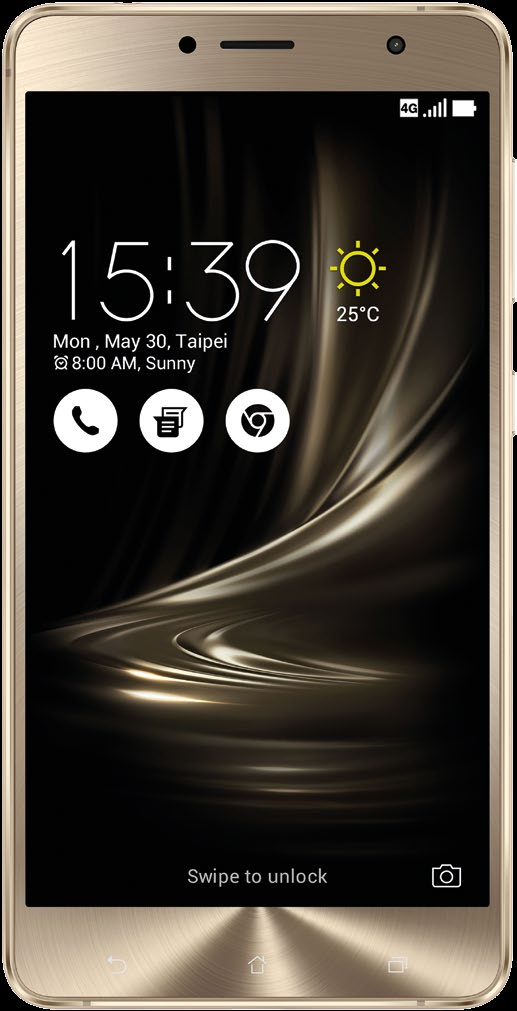ASUS ZenFone 3 Deluxe


ASUS ZenFone 3 Deluxe

AT A GLANCE
Operating system Android 6.0 with ASUS ZenUI 3.0
Processor Qualcomm Snapdragon 820 quad-core (2 x 2.15 GHz Kryo & 2 x 1.6 GHz Kryo)
Display 5.7-inch 1,920 x 1,080 pixels Super AMOLED (386ppi)
Camera 23-megapixel, f/2.0, laser/phase detection autofocus, 1/2.6” sensor size, 1 µm pixel
Price $998
After a string of successful entry and mid-range smartphones, ASUS is setting its sights higher with the ZenFone 3 Deluxe, a $998 premium smartphone that ASUS believes can challenge the likes of Apple and Samsung.
While the regular ZenFone 3 is a mix of metal and glass, the ZenFone 3 Deluxe is all metal, with a sleek unibody design that comes in either Shimmer Gold or Glacier Silver (Titanium Gray is not available locally). Like other ZenFones, the Deluxe has a slightly curved profile, which makes it comfortable to hold. At first glance, the design looks quite similar to many other Android phablets out there, such as Huawei’s Mate 9, but upon closer inspection you’ll notice it’s actually unique because it has no visible antenna bands on the back of the device. If you look closely, you’ll spot three breaks in the front bezel where the antenna peeks out, suggesting that ASUS has managed to build the antenna into the frame of the device. Obviously, if you put your phone in a case, you won’t be able to appreciate this, but it’s a nice feat of engineering nevertheless.
The Deluxe also features the signature ASUS pattern of concentric circles above and beneath the display, and also on the power button and volume rocker, which can both be found on the right-hand side. On the left, a dual nano-SIM card tray, with the second SIM slot doubling up as a MicroSD slot.
On the back of the device there’s a square camera module with a moderate-size camera bump and beneath it an oblong-shaped fingerprint scanner. The skinny fingerprint scanner is a strange bit of hardware. It’s substantially narrower than circular fingerprint scanners and only scans about half the width of your finger, which makes me wonder if it’s less secure than a full-size fingerprint scanner. It is longer than most fingerprint scanners, but that just means you have to line up your finger perfectly along its length to get it to scan correctly.

The camera on the ZenFone 3 Deluxe is a 23-megapixel, f/2.0 Sony IMX318 camera with 3-axis optical image stabilization, and laser autofocus. Unfortunately, more megapixels doesn’t necessarily translate to a better picture and the camera on the ZenFone 3 Deluxe was a little disappointing. Color reproduction and dynamic range are pretty good, but even in good lighting conditions at low ISO levels, there’s a lot of noise and noticeable smearing throughout the shot.
On the bottom of the phone there’s a USB 2.0 Type-C port, and on top there’s a headphone port.
The phone has a 5.7-inch, 1,920 x 1,080 (386ppi) AMOLED display. Other than the iPhone 7 Plus, most of the phablets at this price level use QHD resolutions. Additionally, while colors on the display are quite vivid, the ZenFone 3 Deluxe isn’t as bright as similar sized phablets and, as a result, it’s not easy to see clearly under bright sunlight.
There are actually two versions of the ZenFone 3 Deluxe: one with Qualcomm’s newer Snapdragon 821, and one with the older Snapdragon 820. Unfortunately, only the 820 version is made available in Singapore. The Snapdragon 820 is nearly a year old now, so it’s a bit disappointing to see ASUS launch such an expensive phone with a processor at the end of its shelf life.
Inside the phone is a 3,000mAh battery, which is relatively small for a 5.7-inch phone, and as a result, the Deluxe fared quite poorly on our video looping battery life benchmark, lasting just under nine hours.
The ASUS ZenFone 3 Deluxe is an ambitious phone, but it doesn’t quite deliver everything you expect at this price point. We like the antenna-less rear design, but weren’t too keen on the oblong-shape fingerprint scanner. Camera performance and battery life - two of the most important features of any smartphone today - were also disappointing.
Finally, it’s just too late to launch a Snapdragon 820-powered smartphone. Not only has it already been replaced by the 821, once 2017’s flagship smartphones hit the shelves with Qualcomm’s new 835 processor, the ZenFone 3 Deluxe will feel even more dated.
PICTURES ASUS























